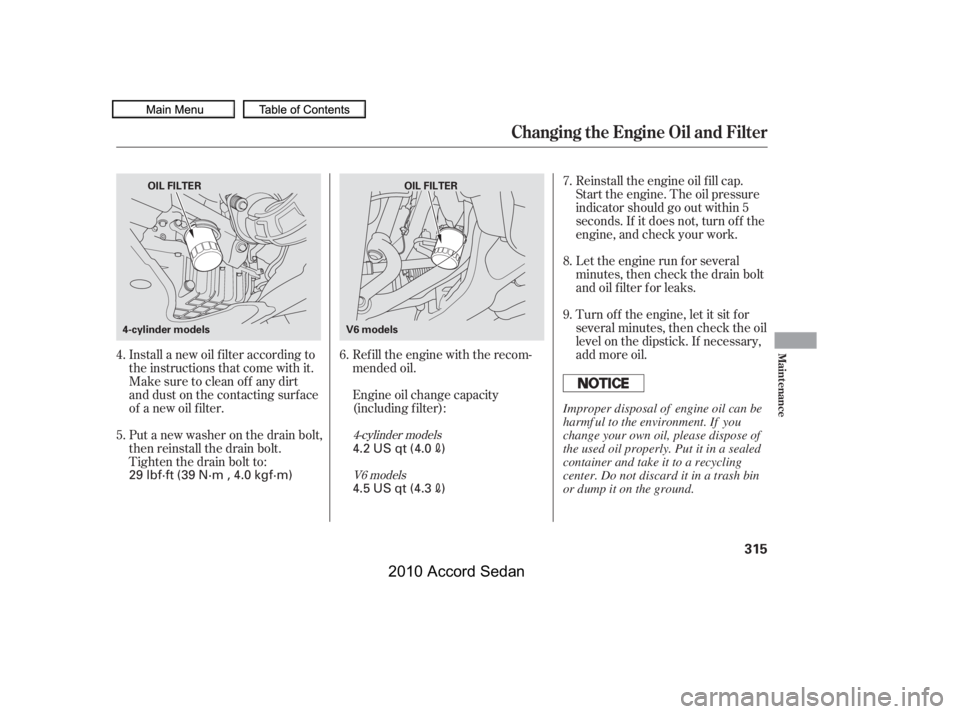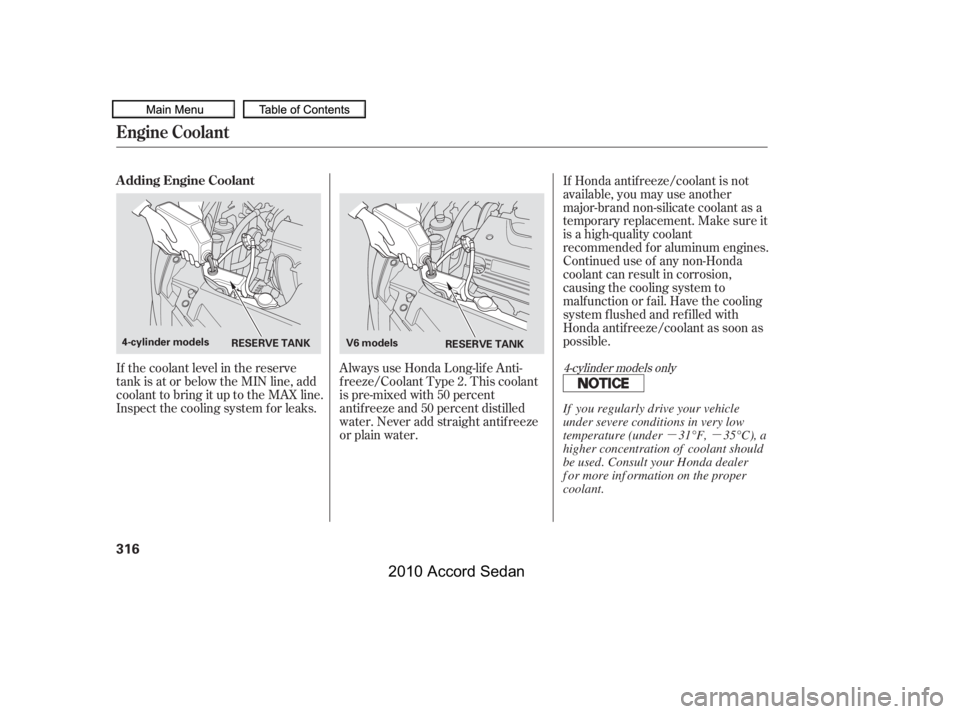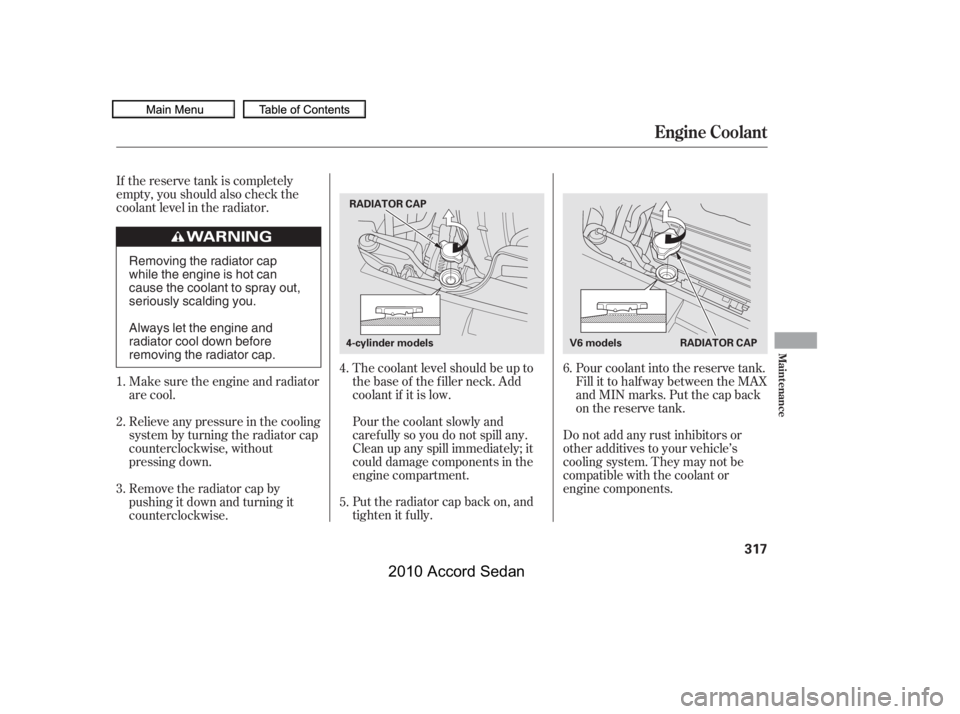Page 289 of 414

The hydraulic system that operates
the brakes has two separate circuits.
Each circuit works diagonally across
the vehicle (the lef t-f ront brake is
connected with the right-rear brake,
etc.). If one circuit should develop a
problem, you will still have braking
at two wheels.
Your vehicle is equipped with disc
brakes at all f our wheels. A power
assist helps reduce the ef f ort needed
on the brake pedal. The emergency
brake assist system increases the
stopping f orce when you depress the
brake pedal hard in an emergency
situation. The anti-lock brake system
(ABS) helps you retain steering
control when braking very hard.
Resting your f oot on the pedal keeps
the brakes applied lightly, builds up
heat, reduces their ef f ectiveness and
reduces brake pad lif e. In addition,
f uel economy can be reduced. It also
keeps your brake lights on all the
time, conf using drivers behind you.
Check the brakes after driving
through deep water. Apply the
brakes moderately to see if they f eel
normal. If not, apply them gently and
f requently until they do. Be extra
cautious in your driving.
Constant application of the brakes
when going down a long hill builds
up heat and reduces their ef f ective-
ness. Use the engine to assist the
brakes by taking your f oot of f the
accelerator and downshif ting to a
lower gear.
The f ront and rear disc brakes on all
models have audible brake pad wear
indicators.
If the brake pads need replacing, you
will hear a distinctive, metallic
screeching sound when you apply
the brake pedal. If you do not have
the brake pads replaced, they will
screech all the time. It is normal f or
the brakes to occasionally squeal or
squeak when you apply them.
Braking System Design
Brake Pad Wear Indicators
Braking System
286
�����—�����—�
���y�
�������������y���
�)�����������y�������
�y
2010 Accord Sedan
Page 315 of 414
Oil is a major contributor to your
engine’s perf ormance and longevity.
Always use a premium-grade 5W-20
detergent oil displaying the API
Certif ication Seal. This seal indicates
the oil is energy conserving, and that
it meets the American Petroleum
Institute’s latest requirements.
Unscrew and remove the engine oil
fill cap on top of the valve cover.
Pour in the oil slowly and caref ully so
you do not spill any. Clean up any
spills immediately. Spilled oil could
damage components in the engine
compartment.
Reinstall the engine oil f ill cap, and
tighten it securely. Wait a f ew
minutes, and recheck the oil level on
the engine oil dipstick. Do not f ill
above the upper mark; you could
damage the engine.
Recommended Engine Oil
A dding Engine Oil
312
ENGINE OIL FILL CAP
V6 models
ENGINE OIL FILL CAP
4-cylinder models
�����—�����—�
���y�
�������������y���
�)�����������y�����
���y
2010 Accord Sedan
Page 318 of 414

Install a new oil f ilter according to
the instructions that come with it.
Refill the engine with the recom-
mended oil.
Engine oil change capacity
(including f ilter):
Let the engine run f or several
minutes, then check the drain bolt
and oil f ilter f or leaks.
Turn of f the engine, let it sit f or
several minutes, then check the oil
level on the dipstick. If necessary,
add more oil.
Make sure to clean of f any dirt
and dust on the contacting surf ace
of a new oil f ilter.
Put a new washer on the drain bolt,
then reinstall the drain bolt.
Tighten the drain bolt to:
Reinstall the engine oil f ill cap.
Start the engine. The oil pressure
indicator should go out within 5
seconds. If it does not, turn of f the
engine, and check your work.
4.
5.
6.
7.
8.
9.
V6 models
4-cylinder models
Changing the Engine Oil and Filter
Maint enance
315
V6 models
OIL FILTEROIL FILTER
4-cylinder models
4.2 US qt (4.0)
29 lbf·ft (39 N·m , 4.0 kgf·m)
4.5 US qt (4.3)
Improper disposal of engine oil can be
harmf ul to the environment. If you
change your own oil, please dispose of
the used oil properly. Put it in a sealed
container and take it to a recycling
center. Do not discard it in a trash bin
or dump it on the ground.
�����—�����—�
���y�
�����������
�y���
�)�����������y���������y
2010 Accord Sedan
Page 319 of 414

�µ�µ
Always use Honda Long-lif e Anti-
f reeze/Coolant Type 2. This coolant
is pre-mixed with 50 percent
antif reeze and 50 percent distilled
water. Never add straight antif reeze
or plain water.
If the coolant level in the reserve
tank is at or below the MIN line, add
coolant to bring it up to the MAX line.
Inspect the cooling system f or leaks.
If Honda antif reeze/coolant is not
available, you may use another
major-brand non-silicate coolant as a
temporaryreplacement.Makesureit
is a high-quality coolant
recommended f or aluminum engines.
Continued use of any non-Honda
coolant can result in corrosion,
causing the cooling system to
malf unction or f ail. Have the cooling
system f lushed and ref illed with
Honda antif reeze/coolant as soon as
possible.
4-cylinder models only
A dding Engine Coolant
Engine Coolant
316
V6 modelsRESERVE TANKRESERVE TANK4-cylinder models
If you regularly drive your vehicle
under severe conditions in very low
temperature (under 31°F, 35°C), a
higher concentration of coolant should
be used. Consult your Honda dealer
f or more inf ormation on the proper
coolant.
�����—�����—�
���y�
�������������y���
�)�����������y�������
�y
2010 Accord Sedan
Page 320 of 414

The coolant level should be up to
the base of the f iller neck. Add
coolant if it is low.
Pourthecoolantslowlyand
caref ully so you do not spill any.
Clean up any spill immediately; it
could damage components in the
engine compartment.
Put the radiator cap back on, and
tighten it fully.
Pour coolant into the reserve tank.
Fill it to half way between the MAX
and MIN marks. Put the cap back
on the reserve tank.
Do not add any rust inhibitors or
other additives to your vehicle’s
cooling system. They may not be
compatible with the coolant or
engine components.
If the reserve tank is completely
empty, you should also check the
coolant level in the radiator.
Remove the radiator cap by
pushingitdownandturningit
counterclockwise.
Relieve any pressure in the cooling
system by turning the radiator cap
counterclockwise, without
pressing down.
Make sure the engine and radiator
are cool.
4.
1.
2.
3.
5.
6.
Engine Coolant
Maint enance
317
RADIATOR CAP
RADIATOR CAP
V6 models4-cylinder models
Removing the radiator cap
while the engine is hot can
cause the coolant to spray out,
seriously scalding you.
Always let the engine and
radiator cool down before
removing the radiator cap.
09/07/08 21:41:58 31TA5620_322
2010 Accord Sedan
Page 322 of 414
Check the f luid level with the engine
at normal operating temperature.
Park the vehicle on level ground.
Start the engine, let it run until the
radiator f an comes on, then shut
of f the engine. For accurate
results, wait about 60 seconds (but
no longer than 90 seconds) bef ore
doing step 2.
Remove the dipstick (yellow loop)
f rom the transmission, and wipe it
with a clean cloth.
Insert the dipstick all the way into
the transmission securely as
shown in the illustration.
1.
2.3.
CONT INUED
Automatic Transmission
T ransmission Fluid
Maint enance
319
V6 models
DIPSTICKDIPSTICK
UPPER MARKLOWERMARK
4-cylinder models4-cylinder models
�����—�����—�
���y�
�������������y���
�)�����������y���������y
2010 Accord Sedan
Page 343 of 414

�Î
�Î
�Î
�Î
The following chart shows the
recommended cold tire pressures f or
most normal driving conditions.
If you check air pressures when the
tires are hot (driven f or several
miles/kilometers), you will see
readings 4 to 6 psi (30 to 40 kPa, 0.3
to 0.4 kgf/cm ) higher than the cold
readings.Thisisnormal.Donotlet
air out to match the recommended
cold air pressure. The tire will be
underinf lated.
While tubeless tires have some
ability to self -seal if they are
punctured, you should look closely
for punctures if a tire starts losing
pressure.
Youshouldgetyourowntire
pressure gauge and use it whenever
you check your tire pressures. This
will make it easier f or you to tell if a
pressure loss is due to a tire problem
and not due to a variation between
gauges.
Thecompactsparetirepressureis:
For convenience, the recommended
tire sizes and cold tire pressures are
on a label on the driver’s doorjamb.
For additional inf ormation about
your tires, see page .384
Cold Tire Pressure
for Normal Driving
Tire Size
Tire Size
Cold Tire Pressure
for Normal Driving
Front/Rear:
Front/Rear:
1:
2:
EX, EX-L
Front/Rear:
LX, LX-P
V6 models
4-cylinder models
1
2
Recommended Tire Pressures
Tires
340
60 psi (420 kPa , 4.2 kgf/cm)P225/50R17 93V
32 psi (220 kPa ,
2.2 kgf/cm)
30 psi (210 kPa ,
2.1 kgf/cm)
P215/60R16 94H
P225/50R17 93V
32 psi (220 kPa ,
2.2 kgf/cm)
�����—�����—�
���y�
���������
���y���
�)�����������y���������y
2010 Accord Sedan
Page 344 of 414

Your tires have wear indicators
molded into the tread. When the
tread wears down, you will see a 1/2
inch (12.7 mm) wide band across the
tread. This shows there is less than
1/16 inch (1.6 mm) of tread lef t on
the tire.
A tire this worn gives very little
traction on wet roads. You should
replace the tire if you can see three
or more tread wear indicators.
Every time you check inf lation, you
should also examine the tires f or
damage, f oreign objects, and wear.
Youshouldlookfor:
Bumps or bulges in the tread or
side of the tire. Replace the tire if
youfindeitherof theseconditions.
Cuts, splits, or cracks in the side
of the tire. Replace the tire if you
can see f abric or cord.
Excessive tread wear.
We strongly recommend that you do
not drive faster than the posted
speed limits and conditions allow. If
you ever drive in a sanctioned
competitive event at sustained high
speeds (over 118 mph or 190 km/h),
be sure to adjust the cold tire
pressuresasshownbelow.If youdo
not, excessive heat can build up and
cause sudden tire f ailure.
Tire pressure f or high speed driving
is the same as f or normal driving.
Tire Size Cold Tire Pressure
V6 models only
4-cylinder models
Tire InspectionHigh Speed Driving
Tires
Maint enance
341
TREAD WEAR INDICATOR
INDICATOR LOCATION MARK
P225/50R17 93V 35 psi (240 kPa ,
2.4 kgf/cm)
�����—�����—�
���y�
�������������y���
�)�����������y���������y
2010 Accord Sedan